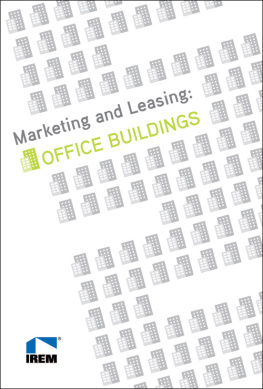
Marketing and Leasing:
RETAIL

IREM Content and Curriculum Development:
Suzanne Hausknecht
Mindy Wallis

2015 by the Institute of Real Estate Management
of the NATIONAL ASSOCIATION OF REALTORS
All rights reserved. Published 2015
Printed in the United States of America
10 Digit: 1-57203-225-1
13 Digit: 978-1-57203-225-5
Ebook ISBN: 978-1-57203-233-0
This book or any part thereof may not be reproduced, stored in a retrieval system, or transmitted, in any form or by any means, electronic, mechanical, photocopying, recording, or otherwise, without the prior written permission of the publisher. Inquiries should be directed to:
Publishing Department
Institute of Real Estate Management
430 North Michigan Avenue
Chicago, IL 606114090.
This publication is designed to provide accurate and authoritative information in regard to the subject matter covered. Forms or other documents included in this book are intended as samples only. Because of changing and varying state and local laws, competent professional advice should be sought prior to the use of any document, form, exhibit, or the like.
This publication is sold with the understanding that the publisher is not engaged in rendering legal, accounting, or any other professional service. If legal advice or other expert assistance is required, the services of a competent professional should be sought.
IREM logo, IREM, CERTIFIED PROPERTY MANAGER, CPM, the CPM key logo, ACCREDITED RESIDENTIAL MANAGER, ARM, the ARM torch logo, ACCREDITED MANAGEMENT ORGANIZATION, AMO, the AMO circle logo, Income/Expense Analysis, Expense Analysis, JPM and MPSA are registered marks of the Institute of Real Estate Management.
Marketing and Leasing:
RETAIL

IREM Content and Curriculum Development:
Suzanne Hausknecht
Mindy Wallis
ACKNOWLEDGEMENTS

We would like to thank the following Review Team for taking time from their personal and professional schedules to provide content and to review this book. Their dedication and support of IREM are greatly appreciated!
REVIEW TEAM MEMBERS
Mez Birdie, CPM Maitland, FL
Shannon Alter, CPM Santa Ana, CA
Richard Muhlebach, CPM, SCSM, CRE, RPA, Woodinville, WA
INTRODUCTION

This book covers effective marketing and leasing tactics specific to retail properties that help achieve the right balance of retailers, increase retail traffic and generate greater sales per square foot.
The following topics are covered:
- MARKET ANALYSIS. Regional and neighborhood demographics and psychographics, trade area mapping, market share analysis, comparison grids for establishing average market minimum rent
- MARKETING STRATEGIES. Shopping center marketing tactics including brand development and social media
- ESSENTIALS OF THE LEASE. Key elements, retail lease provisions, concessions, and lease renewals
- LEASING STRATEGIES. Tenant mix and placement, broker commissions, and qualifying retailers
CHAPTER 1:

Getting Started
A real estate managers knowledge of retail property characteristics and economic factors is necessary for the development of an effective marketing and leasing plan. A property manager must be able to identify shopping center characteristics and the typical duties of the management and leasing staff.
Whats in this chapter:
- Shopping Center Configurations and Types
- Other Types of Retail Properties
Shopping Center Configurations and Types
A shopping center can be defined as a group of commercial stores developed, owned, and managed as an entity. The stores are related in location, size, and type and on-site parking is provided. The centers size and orientation are generally determined by the market characteristics of the trade area served by the center. Shopping centers have traditionally had two main configurations that are apparent in a variety of shopping center types.
Two Common Configurations
Shopping centers have two main configurations, mall and strip center. A mall is two rows of stores separated by a walkwaywhich may be enclosed or open air. A strip center is a row of stores facing a parking lot. Strip centers may be in a straight row, L-shaped or U-shaped. In addition, various hybrids of the traditional mall and strip center configurations exist.

Did you know?

One of the most unique shopping centers in the world is the Dubai Mall in the United Arab Emirates. With 1,200 shops, plus an aquarium and an ice rink, it attracts 65 million visitors.

Shopping Center Types
The definitions below are meant to be guidelines for understanding major differences among the basic types of shopping centers. Several of the categories shown below, such as size, number of anchors, and trade area, should be interpreted as typical for each center type. They are not meant to encompass the operating characteristics of every center. As a general rule, the main determinants in classifying a center are its merchandise (types of goods/services sold) and its size.

Regional Center
- Provides general merchandise (a large percentage of which is soft goods) and services in full depth and variety.
- Main attraction is the combination of anchors (may be traditional, mass merchant, discount, or fashion department stores) with numerous fashion-oriented specialty stores.
- Usually enclosed, with stores having an inward orientation and connected by a common walkway.
- Parking surrounds the outside perimeter.

Next page












